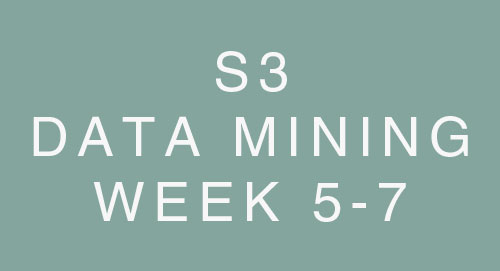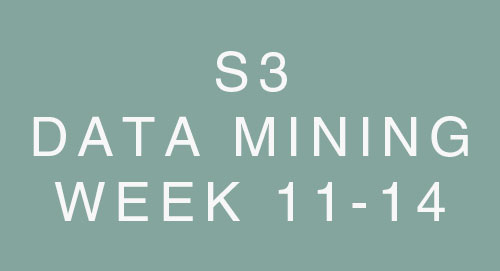Semester 3 - Data Structure & Algorithm
Types of Notations for Time ComplexityPermalink
- These notations illustrate how an algorithm’s time requirement grows with input size.
- They offer a relative measure of efficiency, not exact timings.
 “N”-no. of steps, “n”-input size, From bottom, O(1)-constant, logarithmic-O(log n), square root-O(sqrt n) Linear-O(n), Log linear-O(n log n), Quadratic-O(n2), Exponential-O(2n), Worse-O(n!)
“N”-no. of steps, “n”-input size, From bottom, O(1)-constant, logarithmic-O(log n), square root-O(sqrt n) Linear-O(n), Log linear-O(n log n), Quadratic-O(n2), Exponential-O(2n), Worse-O(n!)
Big O Notation (O)Permalink
- Represents the worst-case scenario for an algorithm.
- Describes the upper limit of time taken.
- Example: O(n) means time increases linearly with input size.
Big Omega Notation (Ω)Permalink
- Represents the best-case scenario for an algorithm.
- Describes the lower limit of time taken.
- Example: Ω(n2) means time is at least proportional to the square of input size.
Big Theta Notation (Θ)Permalink
- Represents both best-case and worst-case scenarios.
- Defines the exact asymptotic behavior.
- Example: Θ(n log n) means time grows with n log n of input size.
Little o Notation (o)Permalink
- Gives an upper limit that is not tight.
- Function grows slower than this limit.
- Example: o(n) means function grows slower than linear time.
Little Omega Notation (ω)Permalink
- Gives a lower limit that is not tight.
- Function grows faster than this limit.
- Example: ω(1) means function grows faster than constant time.
Linear Data StructuresPermalink
- Linear data structures store data in a sequential manner, and operations traverse linearly over elements.
ArraysPermalink
- Collection of elements of the same type.
- Elements stored in contiguous memory locations.
- Supports random access using indices.
- Insertion and deletion operations are time-consuming.
- Memory allocated at compile time (static memory allocation).
- Size must be specified at declaration.
int[] arr = new int[5]; // Declare an array
arr[0] = 1; // Access array elements
arr[1] = 2;

Linked ListsPermalink
- Linear data structure with each element as a separate object.
- Each element (node) contains data and a reference to the next node.
- Last node references null, entry point is the head of the list.
- Operations include insertion, deletion, display, search, and update.
import java.util.LinkedList;
LinkedList<String> linkedList = new LinkedList<>(); // Declare a linked list
linkedList.add("Element1"); // Add elements
linkedList.add("Element2");

Three types of lists
Singly-linked list
- All elements except the last have a reference to the next element in the list.
 Singly linked list
Singly linked list
Circular list
- This type is similar to the single-chained one, but the last element has a reference to the first.
 Circular linked list
Circular linked list
Double-linked list
- The elements in the list have both a reference to the previous and the following element.
 Doubly linked list
Doubly linked list
StacksPermalink
- LIFO (Last In First Out) or FILO (First In Last Out) structure.
- Operations include push, pop, and peek or top.
- Insertion and removal occur at one end, the top.
- Can be implemented using arrays or linked lists.
- Used in applications like reversing a word, parsing, and expression conversion.
import java.util.Stack;
Stack<Integer> stack = new Stack<>(); // Declare a stack
stack.push(10); // Push elements onto the stack
stack.push(20);
int topElement = stack.peek(); // Peek the top element
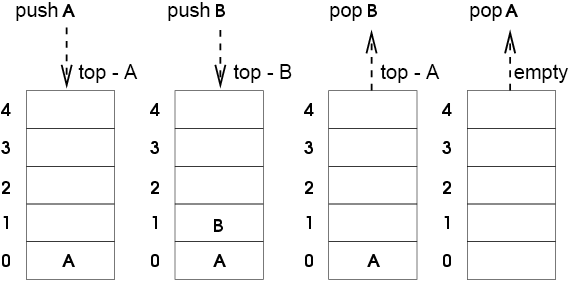 Basic operations of a stack
Basic operations of a stack
QueuesPermalink
- FIFO (First In First Out) data structure.
- Operations include enqueue (add), dequeue (remove), front/head (at dequeue side), and rear/tail (at enqueue side).
- Insertion and removal follow the first in, first out principle.
- Can be implemented using an array, stack, or linked list.
- Used when managing a group of objects where the first one in is also the first one out.
import java.util.Queue;
import java.util.LinkedList;
Queue<Integer> queue = new LinkedList<>(); // Declare a queue
queue.add(10); // Enqueue elements
queue.add(20);
int frontElement = queue.peek(); // Peek the front element
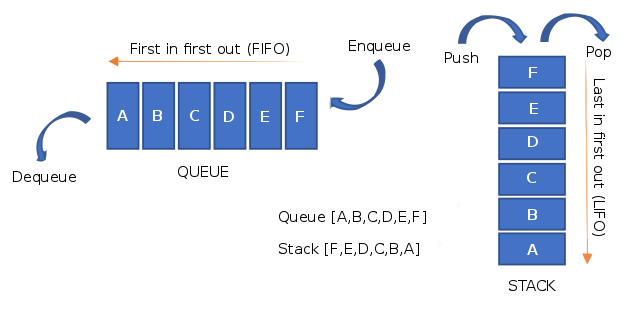 Queue vs Stack
Queue vs Stack
Infix, Prefix and Postfix expressionsPermalink
In-fix: The operator is in between the two operands that it is working on. Example: A + B
Pre-fix (or Polish Notation): The operator is prefixed to operands, i.e., the operator is placed before the operands. For example, +AB
Post-fix (or Reverse Polish Notation: The operator is postfixed to the operands i.e., the operator is placed after the operands. For example, AB+
| Equation (Infix) | Prefix Notation | Postfix Notation | Solution |
|---|---|---|---|
| (2 + 3) * 4 | * + 2 3 4 | 2 3 + 4 * | 20 |
| 4 * (5 + 6) | * 4 + 5 6 | 4 5 6 + * | 44 |
| (7 - 2) / (3 + 2) | / - 7 2 + 3 2 | 7 2 - 3 2 + / | 1 |
| 8 / (2 * (3 - 1)) | / 8 * 2 - 3 1 | 8 2 3 1 - * / | 2 |
| (9 + 4) * (6 - 2) | * + 9 4 - 6 2 | 9 4 + 6 2 - * | 52 |
Infix to Postfix string
Infix Equation: ((A-(B+C))*D)^(E/F)
- Read the equation from left to right.
- Output operands (like A, B, C) immediately.
- If the incoming symbol is ‘(‘, push it onto the stack.
- If it’s an operator (+, -, *, /, ^), pop operators from the stack to the output until you find an operator with less priority or a ‘(‘ on the stack. Then push the incoming operator.
- If the incoming symbol is ‘)’, pop operators from the stack to the output until you find ‘(‘. Pop and discard ‘(‘ from the stack.
- If the incoming symbol is end of the equation, pop all remaining operators from the stack to the output.
- Repeat steps 2-6 until the equation is read completely.
- Now, the output is your postfix equation.
This results in the postfix string A B C + - D * E F / ^.
| Symbol | Postfix String | Stack |
|---|---|---|
| ( | ( | |
| ( | (( | |
| A | A | (( |
| - | A | ((- |
| ( | A | ((-( |
| B | A B | ((-( |
| + | A B | ((-(+ |
| C | A B C | ((-(+ |
| ) | A B C + | ((- |
| * | A B C + | ((* |
| D | A B C + D | ((* |
| ) | A B C + D * | ( |
| ^ | A B C + D * | (^ |
| ( | A B C + D * | (^ ( |
| E | A B C + D * E | (^ ( |
| / | A B C + D * E | (^ (/ |
| F | A B C + D * E F | (^ (/ |
| ) | A B C + D * E F/ | (^ |
| (End) | A B C + D * E F/^ |
Evaluating Postfix
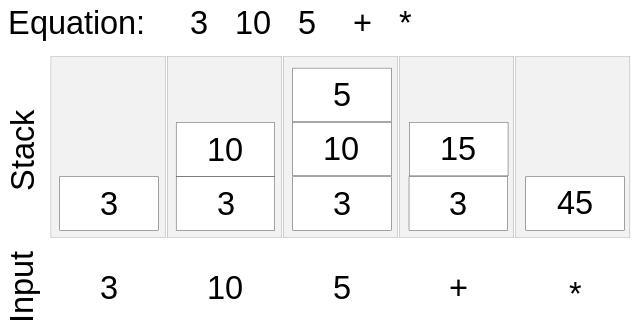 Visual example
Visual example
Steps to evaluate a postfix expression
- Start reading the postfix expression from left to right.
- If the symbol is an operand (i.e., a number or variable), push it onto the stack.
- If the symbol is an operator (i.e., +, -, *, /, ^), then:
- Pop two operands from the stack. The first popped operand is the second operand of the operator, and the second popped operand is the first operand.
- Perform the operation (e.g., addition, subtraction, etc.) on the two operands.
- Push the result back onto the stack.
- Repeat steps 2-3 until the postfix expression is read completely.
- At the end of the evaluation, the stack will contain only one item — the final result. So, pop and return it.


